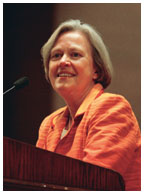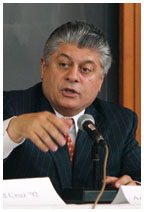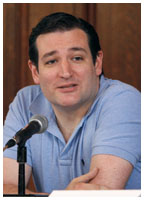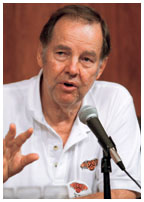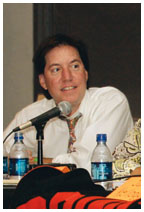
|
July 18, 2007: Features
Reunions pictures featured in the print issue are numerous and will take longer than usual to load. Click here to see reunions images. |
Reunions 2007
Photographs by Beverly Schaefer and Frank Wojciechowski
When Koke Kokatnur ’47 began looking at colleges in the summer of 1942, he boarded a train from his hometown on Long Island, switched at New York’s Penn Station, and in about an hour arrived in a place more beautiful than he had imagined it could be. “Here was this bucolic little college town,” Kokatnur recalled as he stood in front of Nassau Hall in June, some 65 years after his first visit. “It was love at first sight.”
The campus and the town have changed, but Kokatnur keeps coming back. In recent years, he moved from New Jersey to southern California, so the journey requires a little more planning, but for 60 consecutive years, he has found time for Reunions. Bob Tritsch, one of the Class of 1947’s 60th reunion chairmen, is also 60-for-60, and both men were rewarded with orange placards that announced their perfect attendance. “Now we’re saddled with this obligation to show up every year,” Kokatnur joked.
About 20,000 alumni, family members, and guests followed the lead of Kokatnur, Tritsch, and other longtime reuners, returning to Princeton May 31 to June 3 to catch up with college friends and get reacquainted with the University. They came from across the United States and around the world, from China, Malaysia, Australia, and in at least one case, Iraq: Army First Lt. Karim Branford ’04 came to his third reunion during a two-week respite from combat duty.
Reunions activities began Thursday with a handful of receptions and events, including a symposium honoring the 80th birthday of civil engineering professor David Billington ’50. The classroom portion of the weekend hit full stride Friday, with alumni-faculty forums covering campus topics like athletics and the creative and performing arts, and a host of national and international issues. “Looming Large: Perspectives on an Emerging China” was the most popular panel, drawing about 475 people to McCosh 50, and “Civil Liberties in an Age of Countering Terrorism,” which included American Civil Liberties Union executive director Anthony Romero ’87 and Fox News judicial analyst Andrew Napolitano ’72, was not far behind. About 2,300 alumni and guests attended the 14 panel discussions held Friday and Saturday.
Some classes staged forums at their headquarters as well. The Class of 1957, for instance, held a roundtable for alumni authors and a panel with five of its most accomplished class members: former Lockheed Martin CEO Norman Augustine (who also holds a Princeton master’s degree), journalist Hodding Carter, financier Carl Icahn, former New Jersey governor and 9/11 Commission co-chairman Tom Kean, and retired Marine Corps Lt. Gen. Hank Stackpole. Over a Friday-evening dinner in Procter Hall, the Association of Princeton Graduate Alumni honored teachers, with personal tributes to retiring professors and graduate students who had drawn rave reviews from their students.
Except for the thundershowers on Friday evening, Reunions weekend was hot, humid, and sunny, with temperatures reaching the upper 80s. The weather was better suited for wading in the pool outside Robertson Hall than for walking in blazers and ties. At the Class of 1992’s 15th reunion, a water slide that was meant to be a perk for the children of class members turned into fun for the whole family.
On Saturday afternoon, Malcolm Warnock ’25 received the Class of 1923 Cane as the oldest returning alumnus for the second straight year, and members of the Old Guard made their way from a luncheon at Forbes College to the
P-rade’s staging ground, where the Princeton Band played “Going Back to Nassau Hall” to start the procession. About a half-mile down the route on Elm Drive, Charlie Stone ’07 savored his first taste of Reunions. He had heard plenty about the event from his godfather, Sam McKeown ’47, but he purposely avoided coming, deciding to save Reunions for senior year. “It’s really impressive,” Stone said. “You can see alumni in all their different phases of life.”
Class costumes included clever quirks, like ’57’s double-billed baseball caps, which read “Going Back” and “Looking Forward,” and irreverent slogans, like “Beam me up, Shirley,” which graced the backs of ’87’s space-themed T-shirts. The Class of 1967’s railroad-themed delegation included a trolley that acted as the caboose, carrying reuners who sang the class song, and “the good, the bad, and the orange” from the Class of 1992 rolled to the reviewing stand on a horse-drawn wagon, part of the class’s Wild West theme. “We wanted to see all of our classmates from California and New York and New Jersey dressed up like cowboys and cowgirls,” said reunion co-chairman Chad Muir ’92 of Houston, who looked natural in his 10-gallon hat and “1992” belt buckle.
After the Class of 2007 charged onto Poe Field and into the ranks of
alumni, reuners returned to their headquarters for dinner, enjoyed a concert
by the University Orchestra, and watched the annual fireworks display
light up the sky above Lake Carnegie. At the Class of 1982’s tent,
Jersey shore legend Southside Johnny and his band, the Asbury Jukes, headlined
a night full of music and revelry, wrapping up a celebration two years
in the making. Maria Gardner ’82, who chaired the 25th reunion with
Scott Oostdyk ’82, said she sent or received about 10,000 e-mails
in the course of organizing the weekend and spent countless hours on the
phone. “It’s an incredible amount of planning,” Gardner
said, “but at the end of the day, it’s all fun.” ![]()
By B.T.
President Tilghman |
Taking it to the top
President Tilghman touched on a wide variety of topics during her annual Reunions “conversation with alumni.” She said the University has made a major commitment to understanding and remedying the impact of global warming, and said the search for alternate energy sources is “the greatest engineering challenge for the 21st century.” After a challenger questioned Princeton’s stance on global warming, Tilghman replied, “I’ll stand on the scientific evidence on that.”
Ray Maxwell ’51 questioned the University’s approach to legacy admissions, saying that 14 percent of each class is “closed to the general public.” Tilghman replied that the qualifications of legacies who are admitted are “indistinguishable” from those of the rest of the student body, and said that “at most” legacy applicants receive preference in deciding among equally qualified candidates. “It seems only fair to me to tip in favor of the legacy,” she said to applause from most of the audience.
Tilghman also was asked about the end of early admission (she said it was the ethical decision to make, but it could put Princeton at a competitive disadvantage and will be reviewed over time) and about her service on corporate boards (a member of Google’s board, she said she attends four meetings a year and “in return, there are a lot of advantages in the way I think about Princeton and about information technology”).
By W.R.O.
Andrew Napolitano ’72
Ted Cruz ’92
Tom Kean ’57 Joel Achenbach ’82 |
Reunions chatter
At 14 forums and at other events across campus Friday and Saturday, alumni heard classmates and faculty members — all experts on their topics — discuss everything from the legal protections that gay marriage would provide, to moving across career boundaries, to various issues associated with the ongoing war in Iraq. In case you missed them, here is a small smattering of the views expressed.
Civil liberties — take one
“Congress has given the president a power that no tyrant in history has publicly claimed to have. I would think that after an acquittal, after a military commission has found one not guilty, then one would be set free. But the president of the United States in 2007 can keep someone incarcerated past acquittal.” — Andrew Napolitano ’72, former Superior Court judge in New Jersey and a senior judicial analyst for Fox News
Civil liberties — take two
“There is a real difference between the good guys and the bad guys. There’s a lot of talk like, ‘If we do this, we’ll be just like the terrorists.’ But we’re not like them. They want to murder us.” — Ted Cruz ’92, solicitor general for Texas
The 2008 elections
“We have a very good chance that we will have two really remarkable candidates [nominated for president], and by the time this enormously long campaign is over, I’m not sure Jesus Christ could look good in November.” — Martin Franks ’72, executive vice president at CBS
College athletics
“Sports offer a somewhat false world to athletes because it is so brutally objective: You win or you lose; you set a record or you don’t. ... The real world isn’t like that.” — Craig Masback ’77, chief executive officer of USA Track and Field
Success of the 9/11 Commission
“The first thing was an insistence on bipartisanship. ... We made Democrats sit next to Republicans. One of the things the American people were sick of is the partisanship and the nastiness.” — Former New Jersey Gov. Thomas Kean ’57, co-chairman of the 9/11 Commission
The energy problem
“We have had a national policy of keeping gas cheap, and sprawl is a consequence of that. I don’t think we should be in the business of telling people how to live their lives, but I want price signals. ... If the price of gas, with costs internalized, truly is six or seven dollars a gallon, then let’s have the political courage to go that way.” —Roger Liddell ’67, managing director of Ingalls & Snyder LLC
Breast-cancer survival rates
“What’s happened with breast cancer is just phenomenal. Today, because of publicity, the runs, the Walk for the Cure, the five-year survival rate is about 88 percent. That’s all public policy. That’s not surgical skill.” — Tom Williams ’57, associate clinical professor at The Ohio State University Medical School
The nation’s direction
“I believe progressives can make real and significant advances in the next few years. ... And I’m not an optimist by nature.” — Katrina vanden Heuvel ’81, editor and publisher of The Nation
Being gay at Princeton decades ago
“There was not a single openly gay person in my class at the time [I was a student], though over the years I have come to know of at least a dozen gay classmates. ... How I wish we could have known each other then – to chat with, to commiserate with, and perchance to date – but it was not to be.” — David Chambers ’62, emeritus professor of law, University of Michigan
Membership of national commissions
“You can’t put on [these commissions] people who have an ax to grind. It’s really important to put people on who are has-beens. ... We used to kid that the average age on the Iraq Study Group was 75.” — Former secretary of state James A. Baker ’52, co-chairman of the Iraq Study Group
Recruiting Asian-American faculty members
“One of my concerns when I came to Princeton from Berkeley was that I would be the token. I was assured that would not be the case, but after I arrived, it was a little bit the case. ... I have been trying to remind the English department that they made a promise to me that I would not be the last Asian-American.” — Anne Cheng ’85, professor of English
Undergraduate life
“We lived unwired lives, but that created a cultural serendipity, a culture of bumping into one another. ... We didn’t live in cyberspace, we lived in space.” — Joel Achenbach ’82, Washington Post writer
Princeton architecture
“This may be the only campus — or the only place in the country – where you can walk around in two hours and see the architecture of the country.” — University Architect John Hlafter ’61
Jewish life at Princeton
“Ivy, Tiger Inn, and Cottage were male-only, and it was unheard of for a Jew to be a member. Last year, they had a Passover Seder at Ivy Club. I was floored. I couldn’t believe it. That’s a change.” — Marianne Sanua ’82, associate professor of history and Jewish studies, Florida Atlantic University
(Bad) planning
“When you see, in a taxi cab in China, an advertisement for a three-bedroom suburban house with a two-car garage, that’s an example of how another country that was living frugally for a long time is looking at our successes and saying, ‘We want that, too.’” — Elizabeth Plater-Zyberk ’72, architect and co-founder of the New Urbanist movement
Service awards
The Alumni Council honored four alumni with its Award for Service to Princeton this year: William K. Selden ’34, for his many books on Princeton topics — “historical writings [that] have given voice to many facets of the Princeton community” and for his work on numerous alumni committees; John R. Emery ’52, for his class leadership and assistance to younger classes; professor emeritus Robert B. Hollander ’55, for his service as a class volunteer and as a much-loved Princeton professor, including the Reunions Dante seminar he has conducted for 31 years; and April A. Chou ’96, for her work as chairwoman of the Asian American Alumni Association, including her leadership in organizing this year’s Kaleidoscope Conference on Race and Community.
To see PAW’S 2007 Reunions videos and more photos of the major reunion classes, click here.

